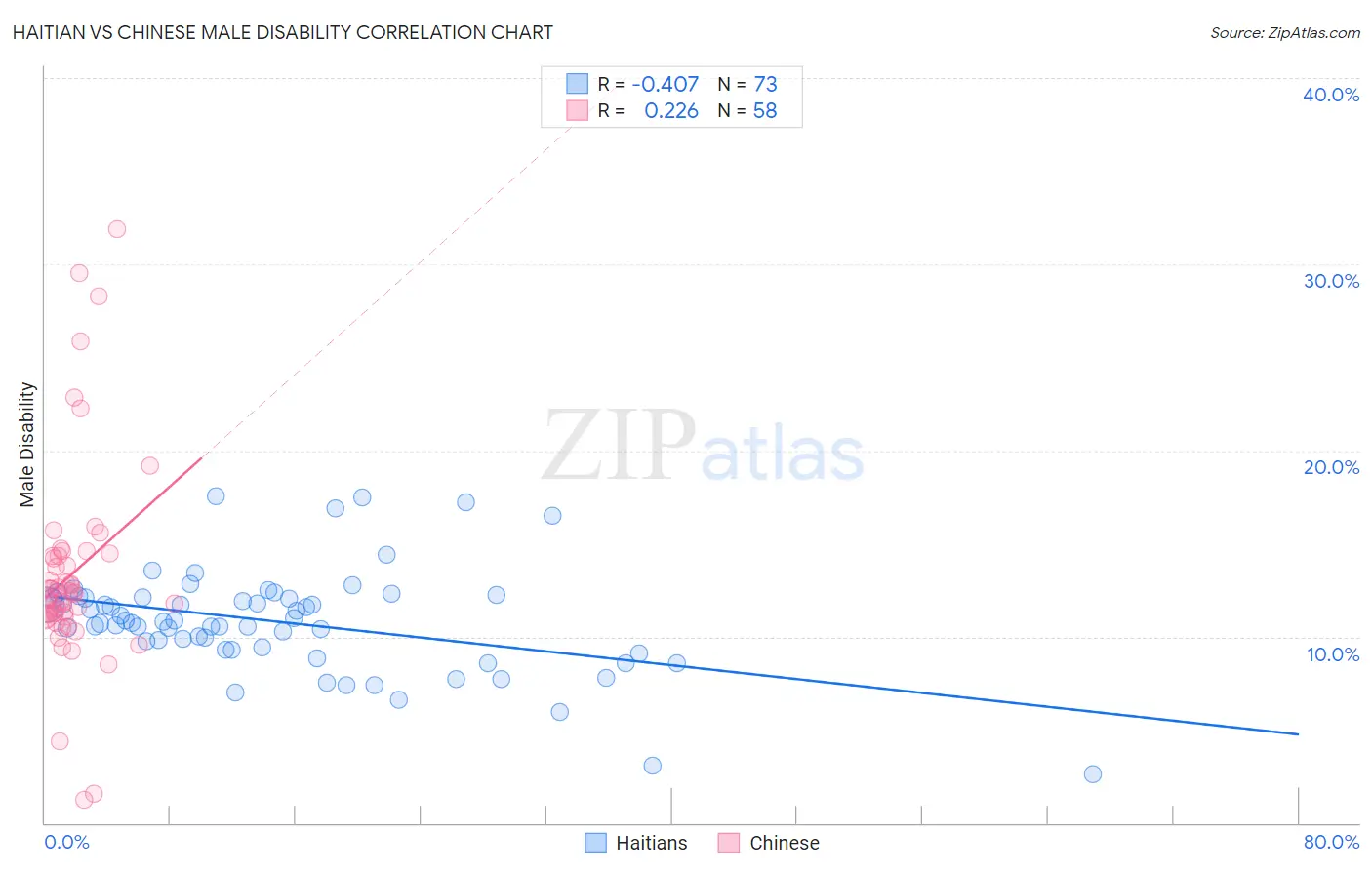Haitian vs Chinese Male Disability
COMPARE
Haitian
Chinese
Male Disability
Male Disability Comparison
Haitians
Chinese
11.2%
MALE DISABILITY
52.5/ 100
METRIC RATING
171st/ 347
METRIC RANK
12.1%
MALE DISABILITY
0.4/ 100
METRIC RATING
255th/ 347
METRIC RANK
Haitian vs Chinese Male Disability Correlation Chart
The statistical analysis conducted on geographies consisting of 287,906,859 people shows a moderate negative correlation between the proportion of Haitians and percentage of males with a disability in the United States with a correlation coefficient (R) of -0.407 and weighted average of 11.2%. Similarly, the statistical analysis conducted on geographies consisting of 64,802,721 people shows a weak positive correlation between the proportion of Chinese and percentage of males with a disability in the United States with a correlation coefficient (R) of 0.226 and weighted average of 12.1%, a difference of 7.7%.

Male Disability Correlation Summary
| Measurement | Haitian | Chinese |
| Minimum | 2.6% | 1.3% |
| Maximum | 17.5% | 31.9% |
| Range | 14.9% | 30.7% |
| Mean | 10.8% | 13.4% |
| Median | 10.8% | 12.4% |
| Interquartile 25% (IQ1) | 9.4% | 11.1% |
| Interquartile 75% (IQ3) | 12.1% | 14.4% |
| Interquartile Range (IQR) | 2.7% | 3.3% |
| Standard Deviation (Sample) | 2.8% | 5.6% |
| Standard Deviation (Population) | 2.7% | 5.5% |
Similar Demographics by Male Disability
Demographics Similar to Haitians by Male Disability
In terms of male disability, the demographic groups most similar to Haitians are New Zealander (11.2%, a difference of 0.020%), Barbadian (11.2%, a difference of 0.050%), Immigrants from Latin America (11.2%, a difference of 0.080%), Immigrants from Southern Europe (11.2%, a difference of 0.10%), and Romanian (11.2%, a difference of 0.10%).
| Demographics | Rating | Rank | Male Disability |
| British West Indians | 62.8 /100 | #164 | Good 11.1% |
| Luxembourgers | 61.9 /100 | #165 | Good 11.1% |
| Immigrants | Hungary | 61.2 /100 | #166 | Good 11.1% |
| Immigrants | Southern Europe | 54.4 /100 | #167 | Average 11.2% |
| Immigrants | Latin America | 54.0 /100 | #168 | Average 11.2% |
| Barbadians | 53.4 /100 | #169 | Average 11.2% |
| New Zealanders | 52.9 /100 | #170 | Average 11.2% |
| Haitians | 52.5 /100 | #171 | Average 11.2% |
| Romanians | 50.7 /100 | #172 | Average 11.2% |
| Immigrants | Burma/Myanmar | 50.4 /100 | #173 | Average 11.2% |
| Maltese | 50.0 /100 | #174 | Average 11.2% |
| Immigrants | Honduras | 48.7 /100 | #175 | Average 11.2% |
| Syrians | 46.6 /100 | #176 | Average 11.2% |
| Immigrants | Norway | 44.2 /100 | #177 | Average 11.3% |
| Australians | 42.2 /100 | #178 | Average 11.3% |
Demographics Similar to Chinese by Male Disability
In terms of male disability, the demographic groups most similar to Chinese are British (12.1%, a difference of 0.010%), Slovene (12.0%, a difference of 0.20%), Guamanian/Chamorro (12.0%, a difference of 0.20%), Swiss (12.1%, a difference of 0.25%), and European (12.1%, a difference of 0.25%).
| Demographics | Rating | Rank | Male Disability |
| Poles | 0.7 /100 | #248 | Tragic 12.0% |
| Immigrants | Yemen | 0.5 /100 | #249 | Tragic 12.0% |
| Bangladeshis | 0.5 /100 | #250 | Tragic 12.0% |
| German Russians | 0.5 /100 | #251 | Tragic 12.0% |
| Slovenes | 0.5 /100 | #252 | Tragic 12.0% |
| Guamanians/Chamorros | 0.5 /100 | #253 | Tragic 12.0% |
| British | 0.4 /100 | #254 | Tragic 12.1% |
| Chinese | 0.4 /100 | #255 | Tragic 12.1% |
| Swiss | 0.3 /100 | #256 | Tragic 12.1% |
| Europeans | 0.3 /100 | #257 | Tragic 12.1% |
| Basques | 0.3 /100 | #258 | Tragic 12.1% |
| Belgians | 0.3 /100 | #259 | Tragic 12.1% |
| Swedes | 0.3 /100 | #260 | Tragic 12.1% |
| Slavs | 0.2 /100 | #261 | Tragic 12.2% |
| Norwegians | 0.2 /100 | #262 | Tragic 12.2% |